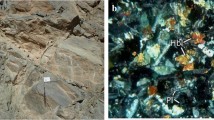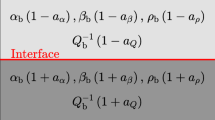Abstract
We show that numerical support of laboratory experiments can significantly increase the understanding and simplify the interpretation of the obtained laboratory results. First we perform simulations of the Seismic Wave Attenuation Module to measure seismic attenuation of reservoir rocks. Our findings confirm the accuracy of this system. However, precision can be further improved by optimizing the sensor positions. Second, we model wave propagation for an ultrasonic pulse transmission experiment used to determine pressure- and temperature-dependent seismic velocities in the rock. Multiple waves are identified in our computer experiment, including bar waves. The metal jacket that houses the sample assembly needs to be taken into account for a proper estimation of the ultrasonic velocities. This influence is frequency-dependent.
Similar content being viewed by others
References
Batzle, M., D. Han, and R. Hofmann (2006), Fluid mobility and frequencydependent seismic velocity — Direct measurements, Geophysics 71,1, N1–N9, DOI: 10.1190/1.2159053.
Burlini, L., L. Arbaret, G. Zeilinger, and J.-P. Burg (2005), High-temperature and pressure seismic properties of a lower crustal prograde shear zone from the Kohistan arc, Pakistan, Geol. Soc. London Spec. Publ. 245, 187–202, DOI: 10.1144/GSL.SP.2005.245.01.09.
Burlini, L., S. Vinciguerra, G. Di Toro, G. De Natale, P. Meredith, J.-P. Burg (2007), Seismicity preceding volcanic eruptions: New experimental insights, Geology 35,2, 183–186, DOI: 10.1130/G23195A.1.
Caricchi, L., L. Burlini, and P. Ulmer (2008), Propagation of P- and S-waves in magmas with different crystal contents: Insights into the crystallinity of magmatic reservoirs, J. Volcanol. Geoth. Res. 178,4, 740–750, DOI: 10.1016/j.jvolgeores.2008.09.006.
Christensen, N.I. (1979), Compressional wave velocities in rocks at high temperatures and pressures, critical thermal gradients, and crustal low-velocity zones, J. Geophys. Res. 84,B12, 6849–6857, DOI: 10.1029/JB084iB12p06849.
Ferri, F., L. Burlini, B. Cesare, and R. Sassi (2007), Seismic properties of lower crustal xenoliths from El Hoyazo (SE Spain): Experimental evidence up to partial melting, Earth Planet. Sc. Lett. 253,1–2, 239–253, DOI: 10.1016/j.epsl.2006.10.027.
Jackson, I., and M.S. Paterson (1987), Shear modulus and internal friction of calcite rocks at seismic frequencies: pressure, frequency and grain size dependence, Phys Earth Planet. In. 45,4, 349–367, DOI: 10.1016/0031-9201(87)90042-2.
Kern, H., S. Gao, Z. Jin, T. Popp, and S. Jin (1999), Petrophysical studies on rocks from the Dabie ultrahigh-pressure (UHP) metamorphic belt, central China: implications for the composition and delamination of the lower crust, Tectonophysics 301,3–4, 191–215, DOI: 10.1016/S0040-1951(98)00268-6.
Kono, Y., M. Ishikawa, and M. Arima (2004), Discontinuous change in temperature derivative of Vp in lower crustal rocks, Geophys. Res. Lett. 31,22, L22601, DOI: 10.1029/2004GL020964.
Lakes, R.S. (2009), Viscoelastic Materials, Cambridge University Press, New York, 461 pp.
Madonna, C., and N. Tisato (2013), A new Seismic Wave Attenuation Module to experimentally measure low-frequency attenuation in extensional mode, Geophys. Prospect. 61,2, 302–314, DOI: 10.1111/1365-2478.12015.
O’Connell, R.J., and B. Budiansky (1977), Viscoelastic properties of fluid-saturated cracked solids, J. Geophys. Res. 82,36, 5719–5735, DOI: 10.1029/JB082i036p05719.
Saenger, E.H., N. Gold, and S.A. Shapiro (2000), Modeling the propagation of elastic waves using a modified finite-difference grid, Wave Motion 31,1, 77–92, DOI: 10.1016/S0165-2125(99)00023-2.
Saenger, E.H., S.A. Shapiro, and Y. Keehm (2005), Seismic effects of viscous Biotcoupling: finite difference simulations on micro-scale, Geophys. Res. Lett. 32,14, L14310, DOI: 10.1029/2005GL023222.
Saenger, E.H., F. Enzmann, Y. Keehm, and H. Steeb (2011), Digital rock physics: Effect of fluid viscosity on effective elastic properties, J. Appl. Geophys. 74,4, 236–241, DOI: 10.1016/j.jappgeo.2011.06.001.
Spencer Jr., J.W. (1981), Stress relaxations at low frequencies in fluid saturated rocks: Attenuation and modulus dispersion, J. Geophys. Res. 86,B3, 1803–1812, DOI: 10.1029/JB086iB03p01803.
Steiner, B., and E.H. Saenger (2012), Comparison of 2D and 3D time-reverse imaging — A numerical case study, Comput. Geosci. 46, 174–182, DOI: 10.1016/j.cageo.2011.12.005.
Author information
Authors and Affiliations
Corresponding author
Rights and permissions
About this article
Cite this article
Saenger, E.H., Madonna, C., Frehner, M. et al. Numerical support of laboratory experiments: Attenuation and velocity estimations. Acta Geophys. 62, 1–11 (2014). https://doi.org/10.2478/s11600-013-0162-9
Received:
Revised:
Accepted:
Published:
Issue Date:
DOI: https://doi.org/10.2478/s11600-013-0162-9




